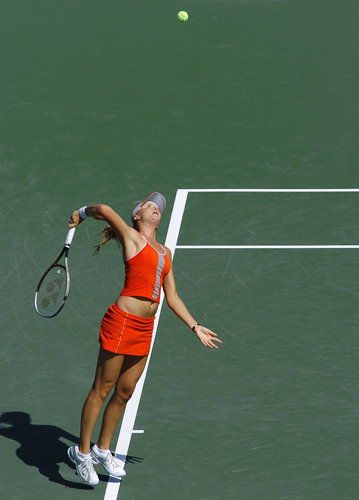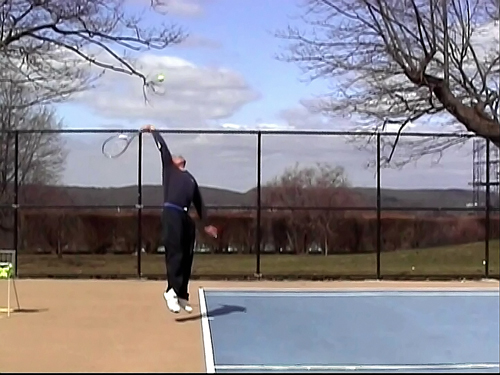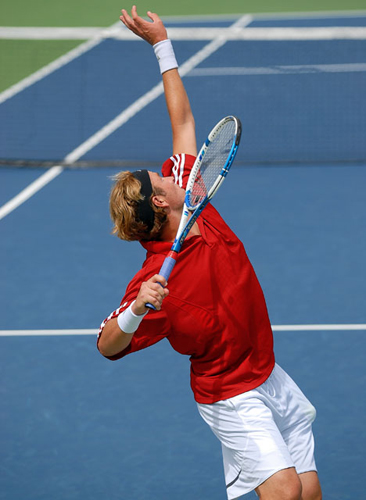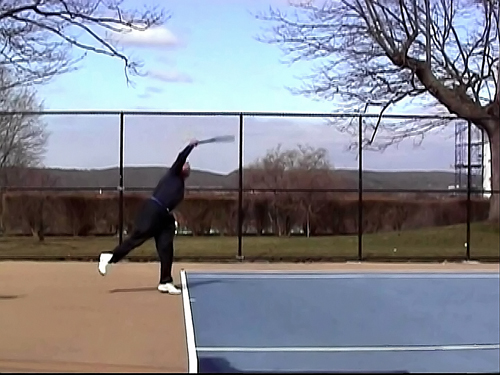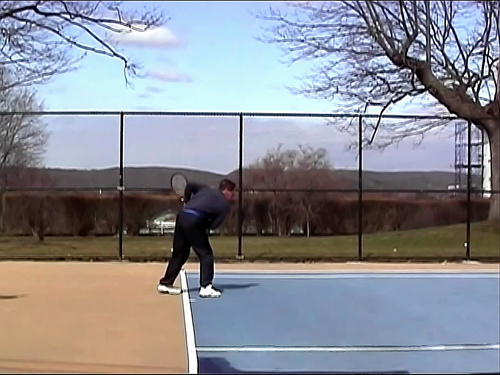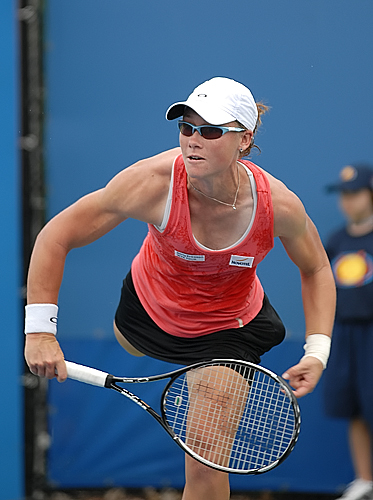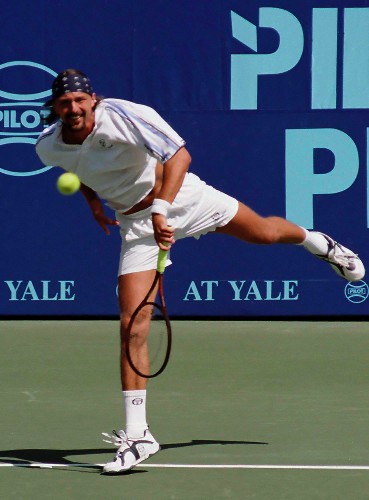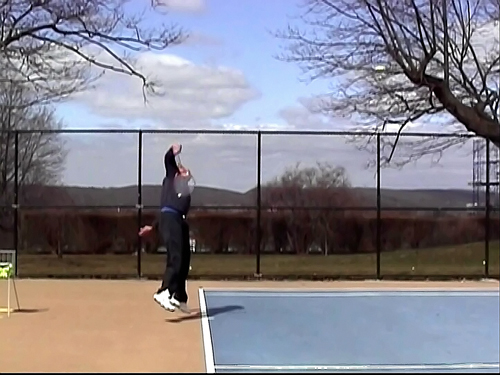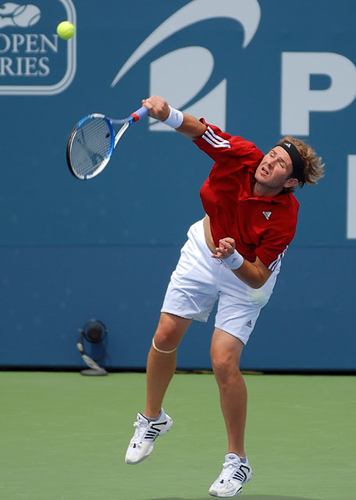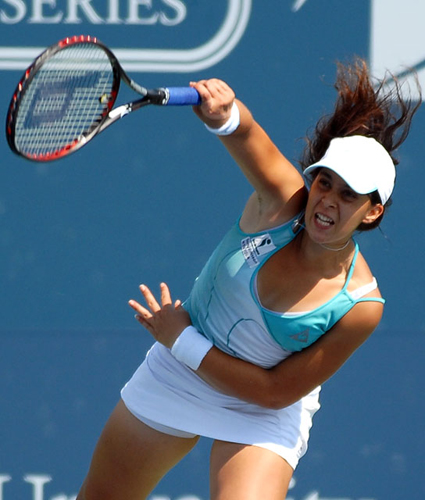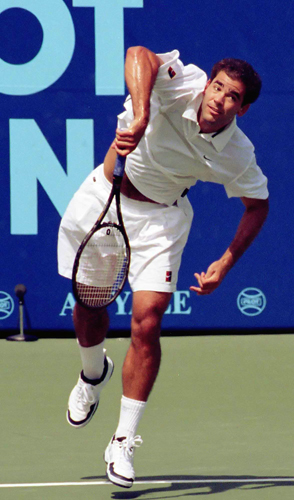May 2007 Article Turbo Tennis Archives:
Tennis Server
|

 |
It is May, and hopefully, all of you tennisphiles have dusted off the gear and are out there enjoying our wonderful sport. Probably, the most difficult stroke to reestablish is the serve. It is a stroke that involves some series of motions that form what is commonly known as the "kinetic chain." Unfortunately, this stroke is probably the hardest stroke to change, once it has been established in a player’s muscle memory. Still, this is the single most important stroke in the game! Why do I say this? Well, a good serve can sometimes win you a point without having to hit another ball. Second, it is the stroke that sets up the point when you are the server. It is the only stroke in the game over which you have "complete control." (Granted, wind and sun can affect this stroke.) Lastly, it is the only stroke that you are afforded two opportunities to hit successfully. Add to the above the fact that you cannot lose a tennis match, if you do not lose your serve, and you see why I place so much emphasis on the serve. I do not allow a training day to go by where I do not do 100 serves in addition to any other training that I may do. I consider this stroke too important to neglect. Changing a service motion is not easy. In fact, it may require the assistance of a teaching pro to really make the changes necessary. However, you can improve your own serve, if you see yourself serving. How can you do this? Videotape yourself serving. You will immediately see what areas need improvement!!! It is early April, as I write this, and the other day, I went out to practice serves in the wind…yes, the wind. How can one learn to serve effectively in the wind, if you don’t practice in these conditions? I decided to take my camcorder (not my high speed camcorder) to replicate what you can do when you videotape yourself serving. Using some software that allows me to isolate still frames, I have included some images of me serving on this particular day. I have also searched for a few images of the pros serving in my collection of images as a sports photographer. Using these together, I hope to provide you with a step by step ritual that will help your serve immensely…I assure you. To serve effectively, you need a good service motion, the ability to visualize your serve, good mental focus…and a consistent ritual. This latter component is an aspect that many players neglect to develop in establishing or reestablishing their serves. Well, this month’s article will give you some insights on the service motion, and some ideas on how to establish a good and consistent serving ritual. The first phase of serving involves waiting until your opponent is ready to receive serve. The rules of the game suggest that the receiver should follow the flow of the server. But in reality, there is some "play" that has to be given the receiver. When I play and am receiving serve, I make certain that I raise my hand in a "stop" motion until I am ready to receive serve. Still, I do not break the rules by unnecessarily delaying my setup! You don’t want to begin a service motion, and then have to stop midway because your opponent is not ready to receive. It interrupts a proper "service flow" if you have to begin the whole motion, again. Here is a shot of Arnaud Clement doing precisely what is necessary before even beginning the service motion…determining if the opponent is ready to receive serve.
The next phase in the service ritual is to lean forward (weight on your front foot), and bounce the ball several times. (I always bounce my ball three times. I never vary this.) I strongly recommend that you lean forward as you do this bouncing of the ball. Why? In serving, you must ultimately have your weight moving forward. This leaning forward helps "remind" the muscle memory to do this forward motion. It doesn’t have to be an extreme lean forward, just have your weight on the front foot. Here is a shot of yours truly doing my bounce phase.
The next phase in your ritual should be what I call the "weight back" phase. The serve requires a back to forward motion. So, I (and many pros) lean back on my rear foot in a somewhat exaggerated manner. To make certain that my weight is fully back, I lift the toe of my front foot. Thus, there is not weight on this front foot. During this phase, I take a long pause. In my mind, I check to see if my opponent has changed his usual receiving position. More importantly, I am visualizing my serve in my mind. I "remind" myself with an image of where I want to place the serve, what spin I want to impart (if any), and what pace I seek. This pause and visualization are, in my mind, absolutely critical in having a good serve!!!
In my ritual, I make certain that before I begin my service motion that I look up to where my toss will be going. I do this deliberately before I begin my toss motion. Here I am doing the head-up, pre-toss posture.
Next, I must identify two distinct service stances. In a book that I highly recommend (okay, I am a bit biased in that I provided the image for the book’s front cover), Biomechanical Principles of Tennis Technique by Duane Knudson, the author identifies two service stances: the foot-back or "platform" technique, and the foot-up or "pinpoint" technique. Here is an image of me serving with the "platform" or foot-back technique.
Here is an image of me serving in the "pinpoint" or foot-up technique.
In the above picture, I have "slid" my back foot forward to allow my feet to be together and forming a "launching" pad for upward movement. You will note that my knees are beginning to bend in the above image. The more I bend my knees the higher I can "launch" myself upward in my serve. In reality, I use both the "platform" and the "pinpoint" techniques. I use the former of these when I am serving a hard, flat, first serve. I also use this "platform" technique if I am going to go forward to serve/volley. For slice and kick serves, I always use the "pinpoint" stance. In fact, I will sometimes use this technique to hit a hard first serve. Undoubtedly, you are saying, "But Ron, aren’t you telegraphing to your opponent what your serve will be?" My answer would be, "Yes." However, if I use the same weight-back and head-up-looking techniques for all my serves, I am not betraying my intent until I have tossed the ball. Although savvy players will pick up on this, they still don’t know where I intend on placing the ball in the service box. I deliberately vary my service patterns to keep this element of surprise…a surprise. In my photographing of the pros on tour, I believe the vast majority of the present day pros use the "pinpoint" stance for all their serves. This is not all that surprising. Surfaces in the modern game (save grass and indoor surfaces) don’t lend themselves as easily to the serve/volley game. If you find 2 out of 10 pros playing serve/volley on a regular basis given hard courts and clay courts, I would be surprised. Still, if you observe pros playing doubles and pros who do play singles with the serve/volley game, you will see that many, if not most, of these use the "platform" stance when serving. Here are some images of Daniela Hantuchova, as she serves with the "pinpoint" technique.
As you can see in the last image in the above series, launching upward to hit the serve is a natural part of the "pinpoint" service technique. The upward motion should be accompanied by some forward angle to the body, if this is a first serve that is being hit for pace. If however, you are hitting a kick serve, the ball toss will probably prevent much forward body angle in your "launch. Here is an image of me hitting a kick serve. The ball has been tossed behind my back. Note that my body is vertical…not forward.
In this picture of Mardy Fish, you can see that his legs are together (suggesting the "pinpoint" stance), but he his angling his body forward as he bends his knees to "launch." This would suggest that he is preparing to hit a flat, first serve.
Returning for a moment to the foot-back, "platform" service technique, here is an image of me making contact with the ball using this serve stance. You will note that my back leg is still behind and separate from my front leg. However, I do have all my weight on the front foot. This allows me to get the forward momentum that I need to generate power on my first serves.
In every stroke in this great game of ours, the finish is critically important! When serving, there are generally two distinct finishes. The first of these is the across the body finish. This finish is what is normally appropriate for flat and slice serves. Here is the finish associated with the foot-back, "platform" stance that I use when hitting my first serves. Note that the forward motion of my body has put me well into the court and that the racquet has finished by moving across my body to the left hand side of my body.
In the image below, we see Samantha Stosur using a similar finish.
For you lefties, here is the great Goran Ivanisevic executing his incredibly powerful, first serve. Although the image may not suggest it clearly, I assure you that he finished this serve with the racquet crossing over to his right side.
The second serve finish is what is usually associated with the kick serve or topspin serve. Here, the racquet finishes on the same side of the body as your dominant hand. To really get the forward spin necessary for either the kick or topspin serve (the former has side spin in addition to topspin), you need to snap the wrist at the moment of impact, and finish the serve in the aforementioned manner. Here, I am finishing my kick serve. I really exaggerate my finish when hitting a kick serve. It is, I believe, one of the reasons that the kick serve is my best serve.
Here is Mardy Fish using this finish.
In this image, we see Marion Bartoli of France using this finish.
Lastly, I include an image of the great Pete Sampras as he finishes one of his kick, second serves.
So, there has been lots of information provided to you in this month’s column. But, to reduce things to "numbers," I offer the following:
My last piece of advice regarding the serve deals with "quieting the head" at the moment of impact. If you try to keep your head up for a fraction of a second after making contact with the ball, you will find that your serves will be more consistent and well-placed. Well, there you have it…serving by numbers. Develop the right rituals and stick to them at all times. Discover what service stance technique(s) work best for you. Practice your serves faithfully!!! Videotape yourself serving…you will learn volumes. I am certain that if you do, you will be well on your way to being a tennis overdog this summer!
1996 - 2002 | 2003 - Present
This column
is copyrighted by Ron Waite, all rights reserved. Questions and comments
about these columns can be directed to Ron by using this form.
Ron Waite is a certified USPTR tennis instructor who took up the game
of tennis at the age of 39. Frustrated with conventional tennis methods
of instruction and the confusing data available on how to learn the
game, Ron has sought to sift fact from fiction. In his seven years of
tennis, Ron has received USTA sectional ranking four years, has successfully
coached several NCAA Division III men's and women's tennis teams to
post season competition, and has competed in USTA National singles tournaments.
Ron has trained at a number of tennis academies and with many of the
game's leading instructors.
In addition to his full-time work as a professor at Albertus Magnus
College, Ron photographs ATP tour events for a variety of organizations
and publications. The name of his column, TurboTennis, stems from his
methods to decrease the amount of time it takes to learn and master
the game of tennis.
|



October 2022 Tennis Anyone: Patterns in Doubles by John Mills. September 2022 Tennis Anyone: Short Court by John Mills. |
 You will join 13,000 other subscribers in receiving news of updates to the Tennis Server along with monthly tennis tips from tennis pro Tom Veneziano.
You will join 13,000 other subscribers in receiving news of updates to the Tennis Server along with monthly tennis tips from tennis pro Tom Veneziano. 








